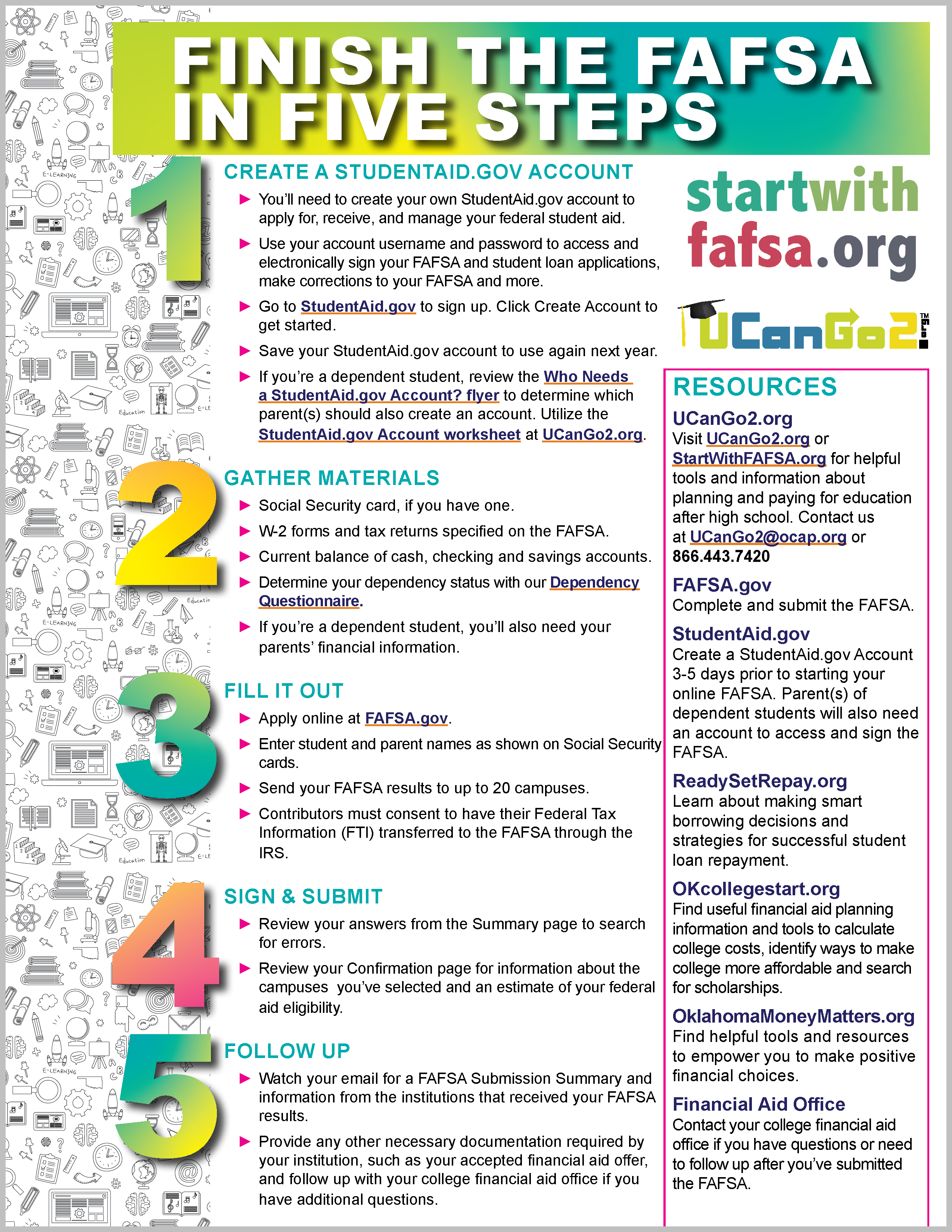Paying for College
Covering College Expenses as an Adult
When it comes to paying for college, it's important to have a plan. Use the tabs below to learn about different types of financial assistance that may be available to you.
- Savings
- Employee Benefits
- Grants/Scholarships
- Federal Aid
- Student Loans
Savings
It's never too late to start saving for college. Even a small amount tucked away can help make ends meet when you're on a tight budget in college. Of course, the earlier you start saving, the more you'll have. Remember each dollar saved for college is one less dollar you'll have to borrow. For help setting up a budget that includes college expenses, check out Oklahoma Money Matters' Budget Calculator.
Next tab: "Employee Benefits"
Employee Benefits
Many companies offer incentives for their employees to go to college. Some may pay tuition, provide stipends or offer flexible work hours so you can attend classes. If you have an employee handbook, look to see if there's a policy about going to school and talk to your employer to learn about your options.
Next tab: "Grants/Scholarships"
Previous tab: "Savings"
Grants/Scholarships
 We refer to grants and scholarships as "free money" or "gift aid" because it's money you can use for college that you won't have to pay back. When looking for college funds, it’s best to seek free money before opting for student loans.
We refer to grants and scholarships as "free money" or "gift aid" because it's money you can use for college that you won't have to pay back. When looking for college funds, it’s best to seek free money before opting for student loans.
Grants and scholarships are offered to college students for a variety of reasons. And, they are available through many sources including your state, your college, private organizations and the federal government.
Be sure to check out local organizations, such as your church and community groups, for local and nationwide scholarships. Check out our scholarships page to search for scholarships by deadline or category.
Remember, scholarships are awarded based on a variety of criteria, including need, merit, residency, field of study, family history, skills, hobbies and volunteer work. Scholarship application deadlines vary, and may be due before you begin classes. Check out your local library to find scholarships and use our Scholarship Success Guide to help improve the quality of your applications.
Next tab: "Federal Aid"
Previous tab: "Employee Benefits"
Federal Aid
The federal government offers many types of financial aid for college including grants, loans and the Federal Work-Study program. The first step to receiving any type of federal financial aid is to complete the Free Application for Federal Student Aid (FAFSA). The FAFSA may also be required for some sources of state aid and some scholarships.
Remember:
- Complete the FAFSA after Oct. 1 each year you need financial aid for college.
- The first letter in FAFSA stands for FREE. Never pay to complete the application.
- Even if you don't think you'll qualify for financial aid, submit the FAFSA anyway. Most students qualify for some type of financial assistance for college.
- The easiest and most efficient way to complete the FAFSA is through the official FAFSA website, StudentAid.gov.
For more information about the FAFSA, including resources, publications and answers to your questions, visit us at StartWithFAFSA.org.
Next tab: "Student Loans"
Previous tab: "Grants/Scholarships"
Student Loans
 You may need to consider student loans to help close the gap between money you've earned/saved and college expenses. Like any other loan, when you take out a student loan, you're making a promise to pay the borrowed money back. Even if you don't graduate, you still have to pay back every dollar you borrow, plus interest. That said, many students take advantage of the benefits offered through student loans... and if you do need to borrow, we're here to help you make wise decisions along the way.
You may need to consider student loans to help close the gap between money you've earned/saved and college expenses. Like any other loan, when you take out a student loan, you're making a promise to pay the borrowed money back. Even if you don't graduate, you still have to pay back every dollar you borrow, plus interest. That said, many students take advantage of the benefits offered through student loans... and if you do need to borrow, we're here to help you make wise decisions along the way.
Here are some tips to consider when borrowing student loans:
- Do your homework.
There are two categories of loans: federal student loans and private loans (sometimes called alternative loans). If you have to borrow to pay for school, do some research. Federal loans often have lower interest rates and flexible repayment options. However, some private loans are becoming more competitive, so take the time to research your options. You'll want the best program available to you. - Borrow only what you need.
When accepting a student loan, know how much money you'll actually need to cover your school expenses, including your basic living expenses for the school term. Many students are offered more loan funds than they actually need. Remember, you don't have to accept all funds offered to you. Be cautious in pursuing additional loans outside those recommended by your financial aid office. - Be salary savvy.
Consider the starting salary for your chosen occupation before taking out student loans. A good rule of thumb is to make sure your student loan payments won't exceed 8 percent of your starting monthly income after graduation. - Don't charge it.
If possible, don't rely on credit cards for tuition or school-related expenses. Some families think it's easier to charge all college expenses to a credit card to avoid completing financial aid paperwork, but the interest on student loans is usually far less than interest on credit cards.
For more tips about student loans, download our Borrow Smart from the Start brochure.
Previous tab: "Federal Aid"





